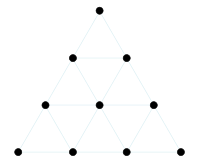10
10 (ten) is the even natural number following 9 and preceding 11. Ten is the base of the decimal numeral system, by far the most common system of denoting numbers in both spoken and written language. It is the first double-digit number. The reason for the choice of ten is assumed to be that humans have ten fingers (digits).
Ten is the fifth composite number. Ten is the smallest noncototient, a number that cannot be expressed as the difference between any integer and the total number of coprimes below it.[1] It is the second discrete semiprime () and the second member of the () discrete semiprime family. Ten has an aliquot sumσ(10) of 8 and is accordingly the first discrete semiprime to be in deficit, with all subsequent discrete semiprimes in deficit.[2] Ten is the smallest number that can be written as the sum of two prime numbers in two different ways ( ), and the only number whose sum and difference of its prime divisors yield prime numbers ( and ). It is also the smallest semiprime that is the sum of all the distinct prime numbers from its lower factor through its higher factor ().[3] In general, powers of 10 contain divisors, where is the number of digits: 10 has 22 = 4 divisors, 100 has 32 = 9 divisors, 1,000 has 42 = 16 divisors, 10,000 has 52 = 25 divisors, and so forth. Ten is the eighth Perrin number, preceded in the sequence by (5, 5, 7).[4]
According to conjecture, ten is the average sum of the proper divisors of the natural numbers if the size of the numbers approaches infinity.[5]
The factorial of ten is equal to the product of the factorials of the first three odd primes, .[6] Ten is also the first number whose fourth power can be written as a sum of two squares in two different ways ( and ).
In the sequence of triangular numbers, indexed powers of 10 in this sequence generate the following sequence of triangular numbers in decimal: 55 (10th), 5,050 (100th), 500,500 (1,000th), ...[7][a]
While 55 is the tenth triangular number, it is also the tenth Fibonacci number, and the largest such number to also be a triangular number.[8]












